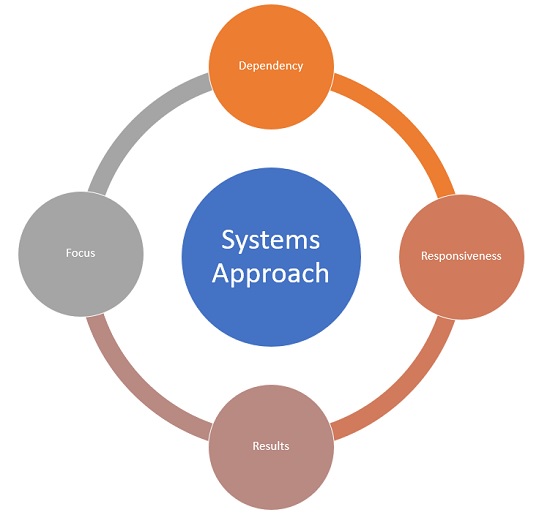- Business Concepts ›
- Marketing and Strategy ›
- Systems Approach
Systems Approach
Definition, Importance, Factors & Example
This article covers meaning & overview of Systems Approach from marketing perspective.
What is meant by Systems Approach?
Systems approach is a management perspective which advocates that any business problem should be seen as system as a whole which is made up of an hierarchy of sub-systems. So rather than seeing the problem in parts it should be seen as whole. Systems approach can be applied to all the business domains like administration, insurance, banking, hospitality etc.
Though it defines system as a whole but it keeps focus on the subsystems and components as well on their role in the entire system. It is linked closely to Systems Thinking. A defined system has a clear boundary and is separate from the environment. This makes it stand apart to look at the problem and its solution. Each subsystem contributes to making this system as a whole.
Many administrators and designers use the system approach to solve and articulate a complex problem. It was first initiated by Ludwing Von Bertalanfty.
Importance of Systems Approach
Systems approach is very important as it provides the bigger picture. It sees all departments and subsystems as contributing factors for the overall organization. Overall success of organizations is seen as a whole and not success of one department over the other.
Let us take a scenario.
If we are facing an issue in a company related to sales and we only see the problem to be solved with the sales department rather than all the departments together we may not be able to solve the problem effectively.
Only focusing on sales will lead to more pressure on sales team to increases sales leading to poor customer experience as the sales department will try hard on upselling or cross selling. But if we use systems approach and see the problem of sales at whole level then we might see that the product quality can be an issue or may be there is not enough marketing done for the product or may be the after sales service is not provided leading to drop in sales figures.
The company can then focus on overall goals and strategy to make sure that a high quality product or service would be produced with great customer experience. That will help not only help the sales problem but overall uplift the company.
Systems approach gives insights into each components' workings and helps see its contribution to the overall system.
Read More
Factors in Systems Approach
1. Dependency
Each part of the system derives inputs and information from other system to achieve the business goal. The parts do not exist in silos but are coupled with one another to work as part of an entire working system.
2. Responsiveness
The system changes as per the environment and reacts to the changes in the environment. If the external environment changes then systems responds as well by making changes in its parameters to stay relevant and work as per expectations.
3. Results
Systems approach is focused on producing right results for the overall system. Each part needs to work according to the requirement of the overall system and product expected results.
All departments and sub-systems of the overall large system need to product results.
Just one or two parts performing well will not help the system.
4. Focus
The focus of each part of the system should be clearly and well defined. e.g. All the departments in the organization should have their clear responsibilities to make the system or organization work. Overlapping responsibilities can reduce the focus and effectiveness of the entire system.

Advantages of Systems approach
The benefits of this approach are:
1. It helps to see the problem at holistic level and resolves the issues
2. Systems approach helps understand the problem in a better way and comes up with more efficient solution
3. It clearly defines the scope or the boundary for systems and problems where in influence of internal and external factors can be seen
Disadvantages of Systems Approach
This approach has its disadvantages:
1. Sometimes problems are too complex and needs focus on the sub-systems rather than keep seeing system as a whole.
2. While designing from bottom to top, focus on sub-systems is required and important details can be left in case focus is only kept on overall system
3. Many a times while solving a specific issue leads to focus on a component and not on overall system
Example of Systems Approach
Let us take an example of an organization which is unable to retain employees in the sales department. So there are two approaches to solve this. The first one is to focus on the sales department only as it is sales issue and the other approach is the systems driven in which the overall picture is seen.
It may be the case that due to poor variable pay and low product quality might be the reason the sales force is reducing. Now the problem was related to the HR subsystem and R&D subsystem and not pertaining to the sales. By addressing the issues, the sales team would become motivated and the problem would get resolved.
Hence, this concludes the definition of Systems Approach along with its overview.
This article has been researched & authored by the Business Concepts Team which comprises of MBA students, management professionals, and industry experts. It has been reviewed & published by the MBA Skool Team. The content on MBA Skool has been created for educational & academic purpose only.
Browse the definition and meaning of more similar terms. The Management Dictionary covers over 1800 business concepts from 5 categories.
Continue Reading:
What is MBA Skool?About Us
MBA Skool is a Knowledge Resource for Management Students, Aspirants & Professionals.
Business Courses
Quizzes & Skills
Quizzes test your expertise in business and Skill tests evaluate your management traits
Related Content
All Business Sections
Write for Us